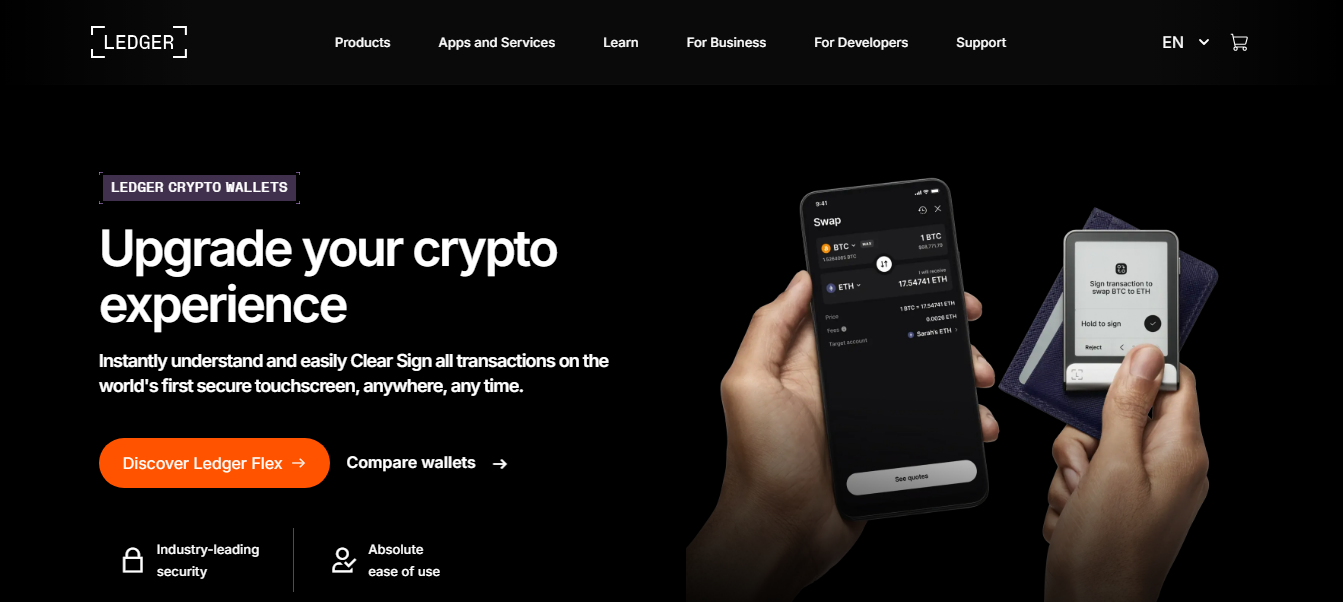✨ Made with Daftpage

Ladger.com/start is the official page provided by Ledger for setting up a Ledger hardware wallet, a device designed to securely store cryptocurrency. Ledger devices, including Ledger Nano X, Ledger Nano S Plus, and Ledger Stax, are hardware wallets that keep private keys offline. Unlike software wallets, which are connected to the internet and vulnerable to hacks, Ledger wallets provide a secure way to store and manage digital assets while maintaining complete control. By using a Ledger device, cryptocurrency users can protect their funds from malware, phishing attacks, and unauthorized access.
When receiving a Ledger device, it is important to check that the packaging is sealed and has not been tampered with. The device should come with a USB cable, recovery sheets, a quick start guide, and the hardware wallet itself. Ledger devices do not come with pre-written recovery phrases. If a 24-word recovery phrase is already provided, the device may be compromised and should not be used. The recovery phrase must always be generated directly on the device during setup to ensure security.
To begin setting up the wallet, go to ladger.com/start in a web browser. It is recommended to type the address manually to avoid phishing sites. On this page, select your Ledger device model and download Ledger Live. Ledger Live is the official application for managing your Ledger wallet. It is available for Windows, macOS, Linux, iOS, and Android. Ledger Live allows users to monitor account balances, send and receive cryptocurrency, install blockchain apps, and view transaction history while keeping private keys securely stored on the device.
After downloading Ledger Live, install and open the application. Click “Get Started” and choose whether to set up a new device or restore an existing wallet using a recovery phrase. If this is the first time using a Ledger device, select “Set up as new device.” Connect your Ledger device to your computer using the USB cable, or via Bluetooth if using a Ledger Nano X. Follow the instructions provided on both the Ledger device and the Ledger Live app to continue the setup.
The first step during setup is creating a PIN code. The PIN provides protection against unauthorized access. Users should choose a code that is easy to remember but difficult for others to guess. The PIN must be entered every time the Ledger device is accessed. If an incorrect PIN is entered multiple times, the device will reset to factory settings to prevent unauthorized access.
After setting the PIN, the device generates a 24-word recovery phrase. This phrase is crucial because it acts as a backup for the private keys stored on the device. If the Ledger is lost, stolen, or damaged, the recovery phrase can be used to restore access to all cryptocurrency accounts on a new device. Write down the 24 words in the exact order on the recovery sheet provided. Never take a photo, store it digitally, or share it with anyone. Anyone with access to the recovery phrase can gain full control of the funds stored on the wallet. Ledger never requests the recovery phrase under any circumstances.
Once the recovery phrase is written, it must be confirmed on the device to ensure it has been recorded correctly. After confirmation, the Ledger wallet is ready for use. Open Ledger Live and connect the device. The app will verify that the device is authentic and will check if the firmware is up to date. Keeping the firmware updated is important for security and provides new features that improve the device.
Next, users should install apps for the cryptocurrencies they plan to use. Each blockchain requires its own app, such as Bitcoin, Ethereum, or Solana. These apps can be installed through the “My Ledger” section of Ledger Live. After installing the apps, add accounts for each cryptocurrency. Ledger Live will display balances and transaction histories for each account, while the private keys remain securely stored on the device.
To receive cryptocurrency, select “Receive” in Ledger Live, choose the account, and verify the address on the Ledger device. Always check that the address on the app matches the address displayed on the device. To send cryptocurrency, click “Send,” enter the recipient’s address and the amount, and confirm the transaction on the device. Transactions cannot be completed without physical approval on the Ledger device, which adds an extra layer of security.
For long-term security, never share the recovery phrase or PIN, and only download Ledger Live from the official website. Keep the recovery sheet in a secure location, such as a safe, and consider using fireproof or waterproof storage. Regularly update Ledger Live and device firmware to ensure that security features remain current.
If the device is lost, stolen, or damaged, the wallet can be restored on a new Ledger device using the 24-word recovery phrase. Enter the words in order, and all cryptocurrency accounts will be restored. Cryptocurrency is stored on the blockchain, not on the device itself. The Ledger device secures access to private keys, keeping them offline and under the user’s control.
Ladger.com/start provides a secure, step-by-step process for setting up a Ledger hardware wallet. It guides users through downloading Ledger Live, creating a PIN, recording and confirming the recovery phrase, installing cryptocurrency apps, and adding accounts. Following these instructions ensures that the wallet is secure, private keys remain protected, and cryptocurrency holdings are safe. Ledger devices allow users to manage digital assets confidently, knowing that private keys are offline and fully under their control. Remember the fundamental rule in cryptocurrency: not your keys, not your coins. Ledger ensures that your keys remain safe, giving peace of mind and protection against online threats.